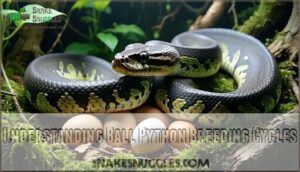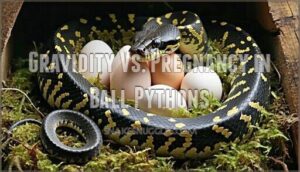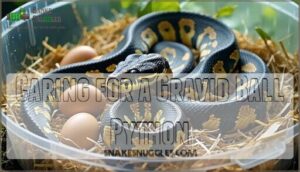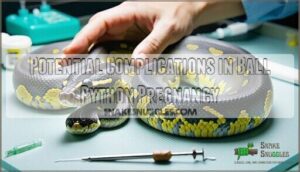This site is supported by our readers. We may earn a commission, at no cost to you, if you purchase through links.
 Wondering if your ball python is pregnant? Ball pythons don’t actually get pregnant like mammals do. Instead, they become "gravid" when carrying fertile eggs.
Wondering if your ball python is pregnant? Ball pythons don’t actually get pregnant like mammals do. Instead, they become "gravid" when carrying fertile eggs.
You’ll notice your snake’s belly getting noticeably thicker in the lower third of her body. She’ll start spending more time in cooler spots and might refuse food completely. Her skin will look tighter and you might see lumps moving under the surface.
Most gravid females become less active and prefer hiding. The whole process from ovulation to egg-laying takes about 55-60 days.
Recognizing these subtle changes early helps you prepare the perfect nesting environment and avoid common mistakes that stress out expecting mothers.
Table Of Contents
- Key Takeaways
- Is Your Ball Python Pregnant?
- Signs of Ball Python Pregnancy
- Understanding Ball Python Breeding Cycles
- Ovulation in Ball Pythons
- Gravidity Vs. Pregnancy in Ball Pythons
- Preparing for Ball Python Egg Laying
- Ball Python Gestation Period
- Caring for a Gravid Ball Python
- Common Misconceptions About Ball Python Pregnancy
- Potential Complications in Ball Python Pregnancy
- Post-Laying Care for Ball Pythons
- Frequently Asked Questions (FAQs)
- Are ball pythons pregnant?
- How do you know if a gravid ball python is pregnant?
- Do gravid ball pythons lay eggs?
- Do ball pythons lay eggs without fertilization?
- Do gravid ball pythons mate year-round?
- Do ball pythons ovulate without mating?
- How to tell if your snake is pregnant?
- How long is a ball python pregnant?
- What months do ball pythons lay eggs?
- How to tell if your ball python is going to lay eggs?
- Conclusion
Key Takeaways
- You’ll recognize a gravid ball python by her thickened midsection with visible lumps, lighter scale coloration, and complete food refusal as she prioritizes egg development over eating.
- Your snake will seek cooler spots, coil around her water bowl, and become less active during the 44-54 day gestation period from ovulation to egg-laying.
- You’ll need to adjust her environment with proper humidity (50-60%), temperature gradients (80-86°F), and softer substrate like sphagnum moss to support her nesting behaviors.
- You should watch for serious complications like egg binding (dystocia) – if she’s straining for over 24 hours without laying eggs or showing visible distress, you’ll need immediate veterinary care.
Is Your Ball Python Pregnant?
Wondering if your ball python is expecting? You’re not alone in this detective work.
A pregnant ball python shows clear signs like a thickening midsection and color changes with increased contrast.
She’ll seek cooler spots, refuse meals, and display "inverted basking" behavior.
These python pregnancy signs help distinguish a truly gravid female from false pregnancy symptoms, ensuring you’re prepared for the exciting journey ahead.
Confirming gravidity can involve palpation and ultrasound.
Signs of Ball Python Pregnancy
You’ll notice your ball python’s body and behavior change in specific ways when she’s carrying eggs.
These changes include physical signs like a thicker midsection and lumpy appearance.
Plus behavioral shifts like seeking cooler spots and refusing food.
Physical Changes
Pregnancy transforms your ball python’s body in unmistakable ways.
Your ball python’s pregnancy journey reveals nature’s remarkable transformation through unmistakable physical and behavioral changes.
The most obvious sign is a lumpy midsection where developing eggs create visible bumps.
Her scale appearance changes too, often becoming lighter with more contrast between colors.
Watch for these key physical changes:
- Body shape shifts to a distinctive "lumpy pyramid" form
- Weight gain becomes noticeable as eggs develop
- Cloacal changes make the opening more pronounced
These signs of pregnancy appear gradually during midsection swelling.
Behavioral Changes
Beyond physical shifts, behavioral changes reveal your gravid ball python’s condition.
You’ll notice appetite fluctuations as she refuses meals, prioritizing egg development.
Basking changes include seeking cooler spots or lying inverted.
Watch for coiling habits around water bowls and increased aggression levels.
These nesting behaviors signal ball python pregnancy – clear signs of pregnancy that confirm your python behavior has shifted toward maternal instincts.
Understanding Ball Python Breeding Cycles
Ball python breeding cycles follow nature’s blueprint, typically starting when cooler weather signals the arrival of breeding seasonality from late September through November.
Understanding these cycles helps you recognize when your female might become gravid and prepares you for potential ball python pregnancy signs.
Here’s what drives successful ball python breeding:
- Temperature triggers: Cooling periods of around 60°F followed by gradual warming activate their natural mating rituals and reproductive instincts.
- Sperm storage capability: Females can retain sperm for weeks or months, allowing clutch frequency to occur even without immediate male presence during ovulation.
- Genetic diversity factors: Multiple pairings with compatible males enhance offspring health and increase successful breeding cycles throughout the season.
These natural breeding cycles directly influence ovulation signs you’ll observe in gravid females preparing for egg-laying.
Successful breeding also depends on proper adult conditioning.
Ovulation in Ball Pythons
You’ll notice ovulation about 84 days after pairing when your ball python’s midsection swells noticeably with developing eggs.
This key milestone triggers major behavioral changes like seeking cooler spots and refusing food as her body prepares for the final pregnancy phase, which can be considered a critical point in the process.
Identifying Ovulation
When your ball python’s mid-body swelling appears overnight, you’ve spotted ovulation in action.
This unmistakable bulge lasts about 24 hours and signals body changes worth celebrating.
Watch for behavioral shifts like refusal to eat and increased water bowl soaking.
These ovulation signs confirm your snake’s reproductive cycle is progressing.
Missing this brief window happens easily, so stay alert.
Post-Ovulation Behavior
Once you’ve spotted ovulation, your ball python’s behavior shifts dramatically.
She’s now officially gravid and preparing for egg-laying ahead.
Here’s what to expect during postovulation behavior:
- Water bowl coiling – She’ll wrap around her water dish like it’s her new best friend
- Complete appetite changes – Don’t panic when she refuses meals for weeks
- Decreased activity – Basking habits change as she conserves energy for developing eggs
Gravidity Vs. Pregnancy in Ball Pythons
The terminology around ball python pregnancy often confuses new owners. Here’s what you need to know about the key differences.
Defining Gravidity in reptilian reproduction differs from mammalian pregnancy. When your ball python carries developing eggs, she’s gravid, not pregnant in the traditional sense.
This physiological difference stems from evolutionary context – reptiles lay eggs while mammals give birth to live young.
| Term | Definition |
|---|---|
| Gravid | Carrying developing eggs inside the body |
| Pregnant | Carrying live embryos (mammals only) |
| Ball Python Gravid | Female with eggs ready for laying |
| Pregnancy Signs | Physical and behavioral changes indicating gravidity |
Understanding gravid vs pregnant terminology helps you better communicate with veterinarians. Your gravid ball python will show pregnancy symptoms like lumping up and behavioral changes.
These pregnancy signs indicate she’s preparing to lay eggs, not give birth to live babies.
Preparing for Ball Python Egg Laying
When your ball python shows signs of pregnancy, you’ll need to prepare the right setup for egg laying about 30 days before she’s due.
Creating the perfect nesting environment now means less stress for both you and your snake when those eggs finally arrive, which is crucial for a successful and healthy egg laying process.
Creating a Suitable Environment
Your gravid ball python needs proper housing to thrive during ball python pregnancy.
Setting up a suitable environment requires attention to detail:
- Tank Size: Provide at least 40 gallons for comfortable movement
- Substrate Choice: Use coconut fiber for ideal humidity monitoring
- Temperature Gradient: Maintain 88-92°F with proper temperature control zones
- Hiding Spots: Install secure hides on both warm and cool sides
To further enrich their habitat, consider natural behavior stimulation.
Nesting Behaviors
When your gravid ball python starts preparing for egg-laying, she’ll display distinct nesting behaviors.
Bowl wrapping becomes common as she seeks comfort around water dishes. Substrate preference shifts toward softer materials like sphagnum moss. These behavioral changes signal approaching labor.
| Nesting Behavior | What You’ll See | Your Action |
|---|---|---|
| Bowl wrapping | Coiling around water dish | Provide larger bowl |
| Substrate digging | Creating depressions | Add softer bedding |
| Hide seeking | Staying in dark spaces | Make secure hides |
| Restless movement | Pacing and exploring | Monitor closely |
Nest construction instincts kick in before the prelay shed occurs. Many owners find success using sphagnum moss bedding to create a comfortable nesting environment.
Ball Python Gestation Period
Understanding your ball python pregnancy timeline helps you prepare for what’s ahead. The python gestation period spans 44 to 54 days from ovulation to egg-laying, with most females averaging around 45 days. This pregnancy duration represents just one phase of a longer process that began months earlier during follicle development.
Your gravid ball python will show distinct changes throughout this gestation period. Here’s what to expect during these vital weeks:
- Physical swelling becomes more pronounced as eggs develop
- Appetite decreases or stops completely due to hormonal shifts
- Temperature-seeking behavior intensifies as she prepares for laying
- Pre-lay shed occurs approximately 20 days after ovulation
- Egg development reaches completion 30-50 days after the shed
The clutch size typically ranges from 4-8 eggs. After laying, incubation time lasts 52-60 days before the hatching process begins. Patience during this waiting period pays off with healthy offspring. Female ball pythons need to reach a certain weight, and breeding size requirements are very important.
Caring for a Gravid Ball Python
Once you’ve confirmed your ball python is gravid you’ll need to adjust her care routine to support her through egg development.
Your pregnant snake needs different feeding schedules and precise temperature control to stay healthy during this important time.
Feeding Requirements
Your gravid ball python will likely refuse to eat during pregnancy. Don’t panic when she skips meals for weeks. Her refusal to eat is normal as her body focuses on developing eggs.
Offer smaller prey every two weeks instead of weekly. Skip supplementation during this period. Fresh water remains important for hydration needs.
| Feeding Aspect | Gravid Python Approach |
|---|---|
| Meal Frequency | Every 2-3 weeks instead of weekly |
| Prey Size | Smaller than normal feeding size |
| Prey Choice | Same species but reduced portions |
| Supplementation | Pause vitamins during pregnancy |
| Refusal Reasons | Natural hormonal changes, not illness |
Temperature and Humidity Control
Environmental control becomes your biggest responsibility when caring for a gravid ball python. You’ll need to maintain temperature gradients between 80-86°F and humidity levels at 50-60%.
Proper monitoring prevents shedding issues and supports healthy egg development. A reptile humidity gauge is essential.
- Use digital monitoring tools to track ideal ranges consistently
- Prepare incubation temperatures at 88-90°F for ball python eggs
- Maintain stable humidity levels to prevent egg desiccation
- Avoid dramatic environmental changes during the gravid period
Common Misconceptions About Ball Python Pregnancy
Ball python owners often fall for misleading breeding myths that can cause unnecessary worry. Let’s clear up these common misconceptions about snake pregnancy signs.
Many people think food refusal always means pregnancy, but gravid ball python females sometimes continue eating. Others believe any behavioral changes confirm pregnancy, yet snakes exhibit these patterns for various reasons.
Male pregnancy is impossible in ball pythons, despite what some forums suggest. Visual confirmation through obvious lumps isn’t always reliable either, as false positives happen when snakes are simply well-fed. One should also be aware that respiratory infections can also cause appetite changes.
| Myth | Reality | What to Look For Instead |
|---|---|---|
| All pregnant females stop eating | Some continue feeding sporadically | Monitor overall appetite changes |
| Lying on side means pregnancy | Could be comfort position | Look for multiple signs together |
| Water bowl basking confirms pregnancy | May indicate dehydration | Check humidity levels first |
| Color changes prove pregnancy | Subtle and not pregnancy-specific | Combine with physical changes |
| Males can become pregnant | Biologically impossible | Focus on female behaviors only |
Don’t rely on single signs for accurate assessment.
Potential Complications in Ball Python Pregnancy
While most ball python pregnancies proceed smoothly, potential complications can arise that require your immediate attention. Think of yourself as your snake’s guardian—staying alert makes all the difference.
Dystocia (egg binding) tops the list of serious concerns. Your female might struggle with retained eggs, oversized eggs, or misshapen eggs that block the reproductive tract. Watch for prolonged straining, lethargy, or visible distress during laying time.
Here are four critical warning signs requiring veterinary intervention:
- Swelling that persists beyond normal gravid appearance
- Lethargy combined with loss of appetite lasting several days
- Straining without producing eggs after 24 hours
- Visible distress like unusual positioning or restlessness
Infertility signs and miscarriage causes often stem from poor nutrition or environmental stress. Maintaining proper humidity can prevent dysecdysis and shedding. Don’t wait—dystocia risks your snake’s life without prompt professional care.
Post-Laying Care for Ball Pythons
Once your ball python lays her eggs you’ll need to focus on two main tasks.
You must handle the eggs properly for incubation while also helping your female recover from the demanding process of egg laying.
Egg Incubation
Once your female lays her clutch, proper egg incubation becomes your top priority.
Here’s how to guarantee healthy hatchlings:
- Maintain humidity levels at 90-100% to prevent eggs from drying out
- Keep incubation temperatures steady at 88-90°F for ideal development
- Choose vermiculite substrate mixed with water for proper moisture retention
- Monitor for hatching problems by candling eggs weekly to check progress
Optimal incubation often requires a specialized reptile incubator.
Maternal Recovery
Your snake needs tender care after laying eggs.
Focus on Hydration Strategies and Postpartum Feeding with smaller meals. Maintain clean conditions for Health Monitoring.
Minimize handling for Stress Reduction. Track her Weight Monitoring progress as she recovers.
| Recovery Focus | Timeline |
|---|---|
| Hydration Strategies | First 48 hours |
| Postpartum Feeding | Week 2-3 |
| Shedding Cycle | 2-4 weeks |
| Enclosure Reintroduction | Gradual process |
| Health Monitoring | Ongoing daily |
Frequently Asked Questions (FAQs)
Are ball pythons pregnant?
Yes, ball pythons can become pregnant through a process called gravidity.
You’ll notice physical signs like lumpy midsections, behavioral changes such as seeking cooler areas, and decreased appetite when your female is carrying eggs, which can be indicators of a condition affecting her appetite.
How do you know if a gravid ball python is pregnant?
Look for visible lumps in her midsection, color changes with lighter scales, decreased appetite, and cool-seeking behavior.
She’ll wrap around water bowls and show a distinctive "lumpy pyramid" body shape near laying time.
Do gravid ball pythons lay eggs?
Around 45 days after ovulation, you’ll see your gravid ball python lay her clutch of eggs.
She’ll deposit 4-10 eggs in a warm, secluded spot, then coil protectively around them until they hatch.
Do ball pythons lay eggs without fertilization?
Ball pythons can ovulate and develop eggs without mating, but they won’t be fertile.
Your female might lay infertile "slug" eggs that are smaller, yellow, and tapered compared to normal white oval eggs.
Do gravid ball pythons mate year-round?
Like clockwork ticking to nature’s rhythm, your gravid ball python won’t mate year-round.
She’ll follow seasonal patterns, typically breeding from late September through November.
Her body needs rest between cycles to recover properly, following a natural cycle that includes breeding periods.
Do ball pythons ovulate without mating?
Yes, your ball python can ovulate without mating.
Ovulation occurs naturally when she’s sexually mature and conditions are right.
However, without fertilization from a male, she’ll only produce infertile eggs called slugs.
How to tell if your snake is pregnant?
Check for visible lumps in your snake’s midsection, color changes with lighter scales, decreased appetite, and cool-seeking behavior.
Your snake might coil around water bowls or lie inverted to regulate temperature during pregnancy.
How long is a ball python pregnant?
Time flies when you’re expecting! Your ball python’s pregnancy lasts approximately 44-50 days from ovulation to egg-laying.
After she lays her clutch, expect those precious eggs to hatch in another 55-60 days.
What months do ball pythons lay eggs?
Ball pythons typically lay eggs during spring and early summer months, from March through July.
Your snake’s timing depends on when breeding occurred, as eggs arrive about 45 days after ovulation happens.
How to tell if your ball python is going to lay eggs?
Look for a lumpy midsection and visible follicles larger than quarters. She’ll seek cooler spots, refuse food, and coil around her water bowl. Pre-lay shedding occurs three weeks before egg-laying.
Conclusion
Recognizing whether your ball python is pregnant becomes straightforward once you know what to look for.
While mammals carry live babies, your snake carries eggs and shows distinct physical changes.
Watch for thicker belly sections, food refusal, and increased hiding behavior.
These signs typically appear 55-60 days before egg-laying.
Remember that proper preparation makes all the difference between a stressful experience and a successful breeding outcome.
Trust your observations and provide the supportive environment your gravid female needs, ensuring a positive outcome with successful breeding.


















